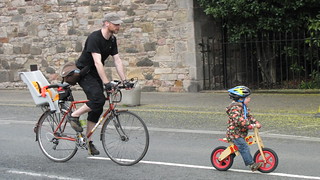What's changed since the 50s though is the dispersal or workplaces and homes to places where the expectation is that travel will be by car. In the 50s if you'd built a workplace out on the edge of town half of your staff wouldn't have been able to get there.
Surely folk were living in suburbs well before then? Much of the semi-detached housing stock dates from the 1920s and 1930s. Think also of factories like Wills tobacco in Glasgow, or even the old Madelvic factory in Edinburgh: hardly city centre locations.
I agree that in the post-war period planners designed in roads rather than railways but this still should not stop buses from working.
The obvious solution is to get on a bike but apparently some people find this impossible.
There's something else going on here and the only explanation I can think of is ideological: people signed up for the American Dream of owning a car, and basing their lives around it. The car is such a symbolically important bit of technology: a lot of this has to do with public display of status, hence the silly competition over who has the newest, most expensive, fanciest, most luxurious, etc. You can't parade around the street with your designer kitchen or leather sofas, but you sure can show off your car!
This I think is why more folk don't get on the bus. They don't feel special on the bus, they're just like everyone else, they're not in control of the schedule, they have to wait, they can only go where the route goes, etc. Even poor people can get the bus. Similarly if they get on a bike they're badged as an eccentric or a loser, someone who can't afford a car, or there is something wrong with them, mentally ill, banned driver, etc.
The allure of the car is that it cocoons the people inside, makes them feel important, massages their egos. Folk are so blinded by this psychological effect that they choose to ignore the consequences of everyone being an egoist: traffic jams, pollution, hollowed out town and city centres, ever slower journey times, etc. Just relax, put some music on, or listen to Drivetime radio, maybe ring a friend on the mobile, complain that the government needs to do more to ease traffic flow, etc....

 posts
posts
